Forecasting and Uncertainty Analysis of Day-Ahead Photovoltaic Power Based on WT-CNN-BiLSTM-AM-GMM
Abstract
1. Introduction
2. Wavelet Transform of Data
3. CNN-BiLSTM-AM Forecasting Model
3.1. Principle of Convolutional Neural Network
- (1)
- Input Layer
- (2)
- Convolutional Layer
- (3)
- Pooling Layer
- (4)
- Fully connected layers
- (5)
- Output Layer
3.2. BiLSTM Model
3.3. Attention Mechanism
3.4. CNN-BiLSTM-AM Model Construction
- (1)
- Input layer: The training data were input into the CNN-BiLSTM-AM. The format of the input data is a matrix of N*M, where N is the length of the time-series training data, and M is the data information of each time point in the time-series training data.
- (2)
- Convolution Layer: The spatial distribution features of the input data were extracted using convolutional operations. The number of convolution kernels is 50, the size of the convolution kernels is 3*3, and the step size is 1.
- (3)
- Pooling Layer: The input high-dimensional feature data are dimensionally reduced to improve the computational speed and prevent the overfitting of the CNN. In this study, the pooling strategy of max-pooling was used, and the size of the pooling kernel was 2*2 with a step size of 2.
- (4)
- Fully Connected Layers: A double fully connected layer structure is adopted in this study. The first fully connected layer combines local features in the pooling layer into global features. The second fully connected layer is used as the regression output layer to output a sequence of feature data.
- (5)
- BiLSTM Layer: mining the temporal correlation of the input data series. Among them, the forward LSTM layer digs the time correlation between the data in a time order. The reverse LSTM layer reversely mines the temporal correlation between the data in the reverse time order. The number of LSTM neurons in the forward and reverse layers is 256.
- (6)
- Attention Mechanism Layer: adaptively adjust the weight of the calculated value of the BiLSTM model for each input data according to the data order to further improve the forecasting accuracy of the BiLSTM model.
- (7)
- Output layer: the forecasting results of the CNN-BiLSTM-AM model are output.
4. Gaussian Mixture Model and WT-CNN-BiLSTM-AM-GMM Model Construction
4.1. Gaussian Mixture Model
4.2. WT-CNN-BiLSTM-AM-GMM Model Construction
- (1)
- Input the NWP data and the power data of the supervisory control and data acquisition (SCADA) system of wind turbine.
- (2)
- Normalize all NWP data and photovoltaic power data to [0, 1], and determine the training and testing datasets.
- (3)
- Divide the normalized training dataset into different datasets according to year, season, and month.
- (4)
- Perform a wavelet transform on all normalized NWP data and photovoltaic power data.
- (5)
- The WT-CNN-BiLSTM-AM model is trained and forecasted using various datasets after the wavelet transformation.
- (6)
- The model forecasting result is reconstructed using a wavelet, and the final forecasting result is obtained.
- (7)
- The distribution characteristics of the forecasting error are calculated, and the confidence interval of the power forecast is calculated.
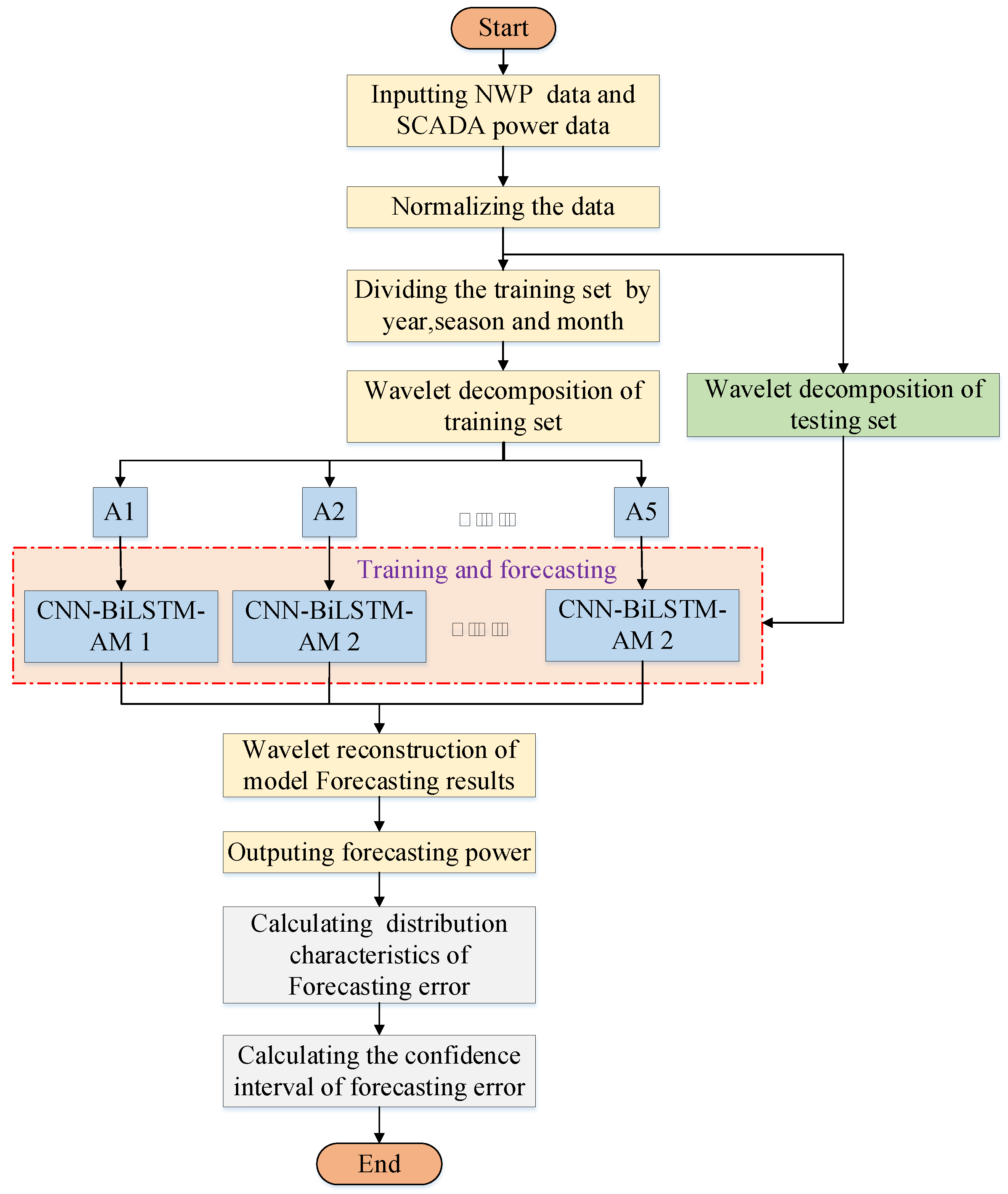
5. Case Study
5.1. Data Source
5.2. Training and Testing Dataset
- (1)
- Testing Dataset
| Season | Weather Type | |||
|---|---|---|---|---|
| Sunny | Cloudy | Overcast | Rainy | |
| Spring | Apr. 29th | Apr. 14th | Apr. 2nd | Apr. 19th |
| Summer | Aug. 13th | Aug. 16th | Aug. 17th | Aug. 5th |
| Autumn | Oct. 12th | Oct. 9th | Oct. 3rd | Oct. 22nd |
| Winter | Dec. 17th | Dec. 15th | Dec. 8th | Dec. 21st |
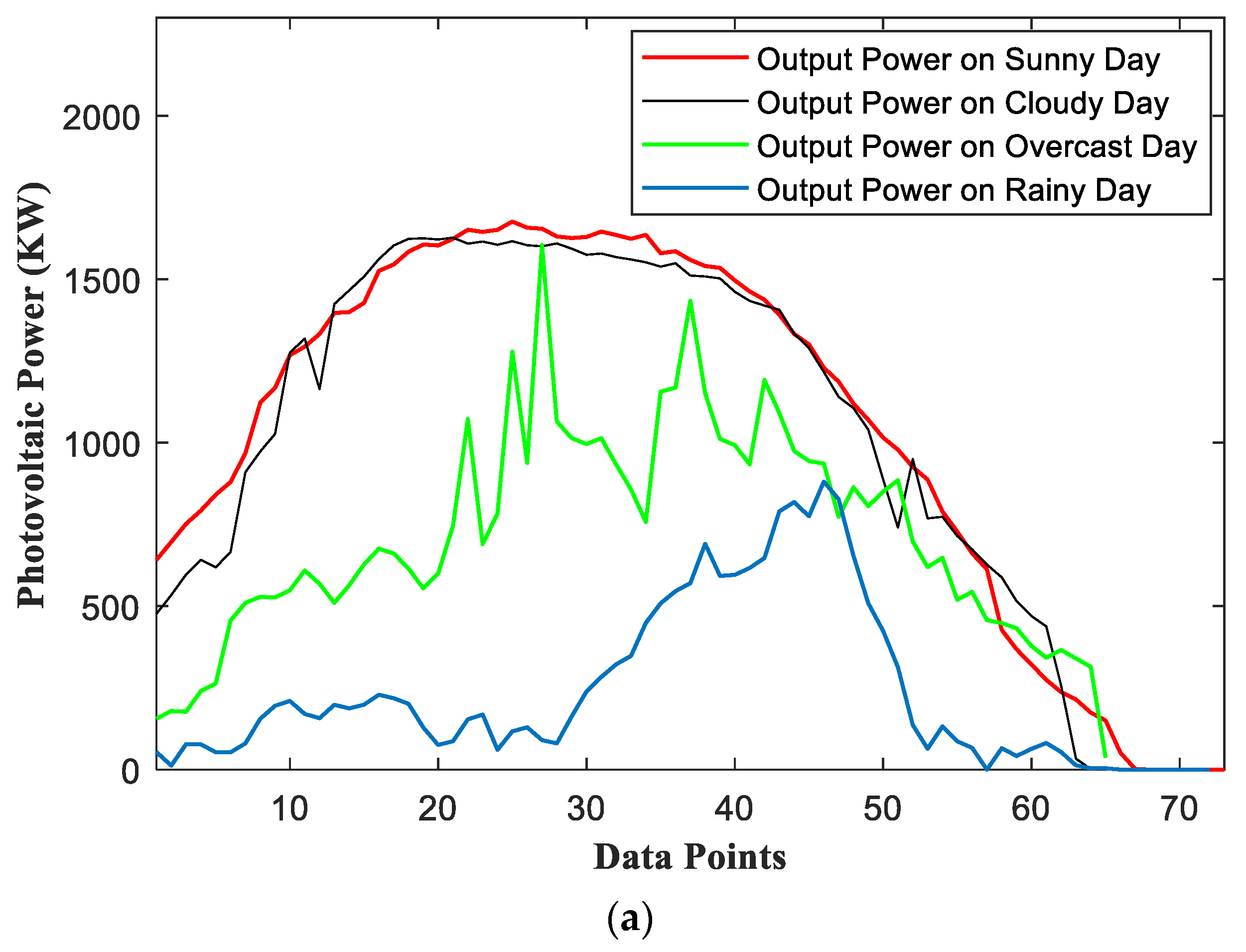
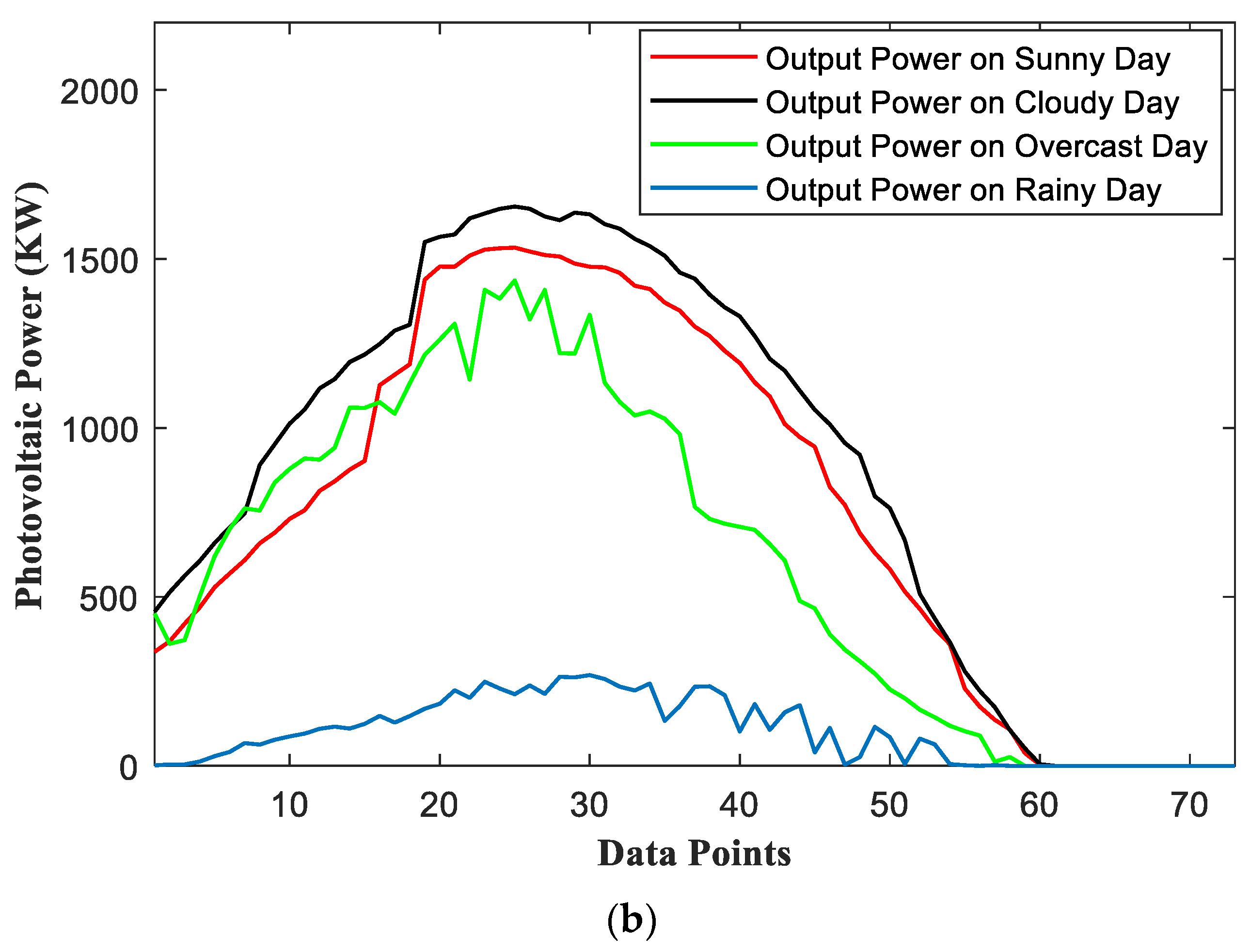
- (2)
- Training Dataset
5.3. Calculation and Analysis
6. Comparison of Different Forecasting Models
7. Uncertainty Analysis of PPF
7.1. Probability Density Estimation of PPF Error
7.2. Confidence Intervals of PPF
8. Conclusions
- (1)
- WT is used to decompose NWP data and photovoltaic power data into frequency data with time information, which can effectively eliminate the impact of randomness and volatility in data information on forecasting accuracy and improve the accuracy of the forecasting model.
- (2)
- The WT-CNN-BiLSTM-AM model can effectively mine the spatial and temporal correlation characteristics of the training dataset and improve the forecasting accuracy of the model.
- (3)
- The forecasting accuracies of WT-CNN-BiLSTM-AM, CNN-BiLSTM, WT-CNN-BiLSTM, LSTM, GRU, and PSO-BP were compared and analyzed, and it was found that under different seasons and weather conditions, the forecasting accuracy of the WT-CNN-BiLSTM-AM model was higher than that of the other models.
- (4)
- The GMM was used to calculate the probability density distribution characteristics of photovoltaic power forecasting errors, and the confidence interval and the coverage of the confidence interval of photovoltaic power forecasting were calculated accordingly. The calculations show that the GMM can accurately describe the probability density distribution characteristics of photovoltaic power forecasting errors compared to the single Gaussian model.
Author Contributions
Funding
Institutional Review Board Statement
Informed Consent Statement
Data Availability Statement
Acknowledgments
Conflicts of Interest
References
- IRENA. Renewable Energy Statistics. 2021. Available online: https://www.irena.org/publications/2021/March/RenewableCapacityStatistics2021 (accessed on 31 March 2021).
- Ahmed, R.; Sreeram, V.; Mishra, Y.; Arif, M. A review and evaluation of the state-of-the-art in PV solar power forecasting: Techniques and optimization. Renew. Sustain. Energy Rev. 2020, 124, 109792. [Google Scholar] [CrossRef]
- Antonanzas, J.; Osorio, N.; Escobar, R.; Urraca, R.; Martinez-De-Pison, F.J.; Antonanzas-Torres, F. Review of photovoltaic power forecasting. Sol. Energy 2016, 136, 78–111. [Google Scholar] [CrossRef]
- Yang, D.; Kleissl, J.; Gueymard, C.A.; Pedro, H.T.; Coimbra, C.F. History and trends in solar irradiance and PV power forecasting: A preliminary assessment and review using text mining. Sol. Energy 2018, 168, 60–101. [Google Scholar] [CrossRef]
- Han, S.; Qiao, Y.-H.; Yan, J.; Liu, Y.-Q.; Li, L.; Wang, Z. Mid-to-long term wind and photovoltaic power generation prediction based on copula function and long short term memory network. Appl. Energy 2019, 239, 181–191. [Google Scholar] [CrossRef]
- Ding, S.; Li, R.; Tao, Z. A novel adaptive discrete grey model with time-varying parameters for long-term photovoltaic power generation forecasting. Energy Convers. Manag. 2020, 227, 113644. [Google Scholar] [CrossRef]
- Hassan, M.A.; Bailek, N.; Bouchouicha, K.; Nwokolo, S.C. Ultra-short-term exogenous forecasting of photovoltaic power production using genetically optimized non-linear auto-regressive recurrent neural networks. Renew. Energy 2021, 171, 191–209. [Google Scholar] [CrossRef]
- Sobrina, S.; Sam, K.K.; Nasrudin, A.R. Solar Photovoltaic Generation Forecasting Methods: A Review. Energy Convers. Manag. 2018, 156, 459–497. [Google Scholar] [CrossRef]
- Das, U.K.; Tey, K.S.; Seyedmahmoudian, M.; Mekhilef, S.; Idris, M.Y.I.; Van Deventer, W.; Horan, B.; Stojcevski, A. Forecasting of photovoltaic power generation and model optimization: A review. Renew. Sustain. Energy Rev. 2018, 81, 912–928. [Google Scholar] [CrossRef]
- Ramirez-Vergara, J.; Bosman, L.B.; Wollega, E.; Leon-Salas, W.D. Review of Forecasting Methods to Support Photovoltaic Predictive Maintenance. Clean. Eng. Technol. 2022, 8, 100460. [Google Scholar] [CrossRef]
- Mayer, M.J. Influence of design data availability on the accuracy of physical photovoltaic power forecasts. Sol. Energy 2021, 227, 532–540. [Google Scholar] [CrossRef]
- Mayer, M.J.; Gróf, G. Extensive comparison of physical models for photovoltaic power forecasting. Appl. Energy 2021, 283, 116239. [Google Scholar] [CrossRef]
- Ramadhan, R.A.; Heatubun, Y.R.; Tan, S.F.; Lee, H.-J. Comparison of physical and machine learning models for estimating solar irradiance and photovoltaic power. Renew. Energy 2021, 178, 1006–1019. [Google Scholar] [CrossRef]
- van der Meer, D.; Widén, J.; Munkhammar, J. Review on probabilistic forecasting of photovoltaic power production and electricity consumption. Renew. Sustain. Energy Rev. 2018, 81, 1484–1512. [Google Scholar] [CrossRef]
- Dubey, A.K.; Kumar, A.; García-Díaz, V.; Sharma, A.K.; Kanhaiya, K. Study and analysis of SARIMA and LSTM in forecasting time series data. Sustain. Energy Technol. Assess. 2021, 47, 101474. [Google Scholar] [CrossRef]
- Belmahdi, B.; Louzazni, M.; El Bouardi, A. One month-ahead forecasting of mean daily global solar radiation using time series models. Optik 2020, 219, 165207. [Google Scholar] [CrossRef]
- AlShafeey, M.; Csáki, C. Evaluating neural network and linear regression photovoltaic power forecasting models based on different input methods. Energy Rep. 2021, 7, 7601–7614. [Google Scholar] [CrossRef]
- David, M.; Martin, J.M. Comparison of Machine Learning Methods for Photovoltaic Power Forecasting Based on Numerical Weather Prediction. Renew. Sustain. Energy Rev. 2022, 161, 112364. [Google Scholar]
- Akhter, M.N.; Mekhilef, S.; Mokhlis, H.; Shah, N.M. Review on forecasting of photovoltaic power generation based on machine learning and metaheuristic techniques. IET Renew. Power Gener. 2019, 13, 1009–1023. [Google Scholar] [CrossRef]
- Gu, B.; Shen, H.; Lei, X.; Hu, H.; Liu, X. Forecasting and uncertainty analysis of day-ahead photovoltaic power using a novel forecasting method. Appl. Energy 2021, 299, 117291. [Google Scholar] [CrossRef]
- Wang, X.; Sun, Y.; Luo, D.; Peng, J. Comparative study of machine learning approaches for predicting short-term photovoltaic power output based on weather type classification. Energy 2021, 240, 122733. [Google Scholar] [CrossRef]
- Wang, J.; Zhou, Y.; Li, Z. Hour-ahead photovoltaic generation forecasting method based on machine learning and multi objective optimization algorithm. Appl. Energy 2022, 312, 118725. [Google Scholar] [CrossRef]
- Rodríguez, F.; Martín, F.; Fontán, L.; Galarza, A. Ensemble of machine learning and spatiotemporal parameters to forecast very short-term solar irradiation to compute photovoltaic generators’ output power. Energy 2021, 229, 120647. [Google Scholar] [CrossRef]
- Li, B.; Delpha, C.; Diallo, D.; Migan-Dubois, A. Application of Artificial Neural Networks to photovoltaic fault detection and diagnosis: A review. Renew. Sustain. Energy Rev. 2021, 138, 110512. [Google Scholar] [CrossRef]
- Pazikadin, A.R.; Rifai, D.; Ali, K.; Malik, M.Z.; Abdalla, A.N.; Faraj, M.A. Solar irradiance measurement instrumentation and power solar generation forecasting based on Artificial Neural Networks (ANN): A review of five years research trend. Sci. Total Environ. 2020, 715, 136848. [Google Scholar] [CrossRef] [PubMed]
- Natarajan, Y.; Kannan, S.; Selvaraj, C.; Mohanty, S.N. Forecasting energy generation in large photovoltaic plants using radial belief neural network. Sustain. Comput. Inform. Syst. 2021, 31, 100578. [Google Scholar] [CrossRef]
- Moreira, M.; Balestrassi, P.; Paiva, A.; Ribeiro, P.; Bonatto, B. Design of experiments using artificial neural network ensemble for photovoltaic generation forecasting. Renew. Sustain. Energy Rev. 2020, 135, 110450. [Google Scholar] [CrossRef]
- Ma, X.; Zhang, X. A short-term prediction model to forecast power of photovoltaic based on MFA-Elman. Energy Rep. 2022, 8, 495–507. [Google Scholar] [CrossRef]
- Kumari, P.; Toshniwal, D. Deep learning models for solar irradiance forecasting: A comprehensive review. J. Clean. Prod. 2021, 318, 128566. [Google Scholar] [CrossRef]
- Aslam, S.; Herodotou, H.; Mohsin, S.M.; Javaid, N.; Ashraf, N.; Aslam, S. A survey on deep learning methods for power load and renewable energy forecasting in smart microgrids. Renew. Sustain. Energy Rev. 2021, 144, 110992. [Google Scholar] [CrossRef]
- Wang, H.; Lei, Z.; Zhang, X.; Zhou, B.; Peng, J. A review of deep learning for renewable energy forecasting. Energy Convers. Manag. 2019, 198, 111799. [Google Scholar] [CrossRef]
- Etxegarai, G.; López, A.; Aginako, N.; Rodríguez, F. An Analysis of Different Deep Learning Neural Networks for Intra-hour Solar Irradiation Forecasting to Compute Solar Photovoltaic Generators’ Energy Production. Energy Sustain. Dev. 2022, 68, 1–17. [Google Scholar] [CrossRef]
- Mellit, A.; Pavan, A.M.; Lughi, V. Deep learning neural networks for short-term photovoltaic power forecasting. Renew. Energy 2021, 172, 276–288. [Google Scholar] [CrossRef]
- Zang, H.; Cheng, L.; Ding, T.; Cheung, K.W.; Wei, Z.; Sun, G. Day-ahead photovoltaic power forecasting approach based on deep convolutional neural networks and meta learning. Int. J. Electr. Power Energy Syst. 2020, 118, 105790. [Google Scholar] [CrossRef]
- Huang, X.; Li, Q.; Tai, Y.; Chen, Z.; Zhang, J.; Shi, J.; Gao, B.; Liu, W. Hybrid deep neural model for hourly solar irradiance forecasting. Renew. Energy 2021, 171, 1041–1060. [Google Scholar] [CrossRef]
- Lai, C.S.; Zhong, C.; Pan, K.; Ng, W.W.; Lai, L.L. A deep learning based hybrid method for hourly solar radiation forecasting. Expert Syst. Appl. 2021, 177, 114941. [Google Scholar] [CrossRef]
- Tang, Y.; Yang, K.; Zhang, S.; Zhang, Z. Photovoltaic power forecasting: A hybrid deep learning model incorporating transfer learning strategy. Renew. Sustain. Energy Rev. 2022, 162, 112473. [Google Scholar] [CrossRef]
- Qu, J.; Qian, Z.; Pei, Y. Day-ahead hourly photovoltaic power forecasting using attention-based CNN-LSTM neural network embedded with multiple relevant and target variables prediction pattern. Energy 2021, 232, 120996. [Google Scholar] [CrossRef]
- Khan, W.; Walker, S.; Zeiler, W. Improved solar photovoltaic energy generation forecast using deep learning-based ensemble stacking approach. Energy 2022, 240, 122812. [Google Scholar] [CrossRef]
- Akhter, M.N.; Mekhilef, S.; Mokhlis, H.; Ali, R.; Usama, M.; Muhammad, M.A.; Khairuddin, A.S.M. A hybrid deep learning method for an hour ahead power output forecasting of three different photovoltaic systems. Appl. Energy 2021, 307, 118185. [Google Scholar] [CrossRef]
- Akhter, M.N.; Mekhilef, S.; Mokhlis, H.; Almohaimeed, Z.M.; Muhammad, M.A.; Khairuddin, A.S.M.; Akram, R.; Hussain, M.M. An Hour-Ahead PV Power Forecasting Method Based on an RNN-LSTM Model for Three Different PV Plants. Energies 2022, 15, 2243. [Google Scholar] [CrossRef]
- Wen, X.; Abbes, D.; Francois, B. Modeling of photovoltaic power uncertainties for impact analysis on generation scheduling and cost of an urban micro grid. Math. Comput. Simul. 2020, 183, 116–128. [Google Scholar] [CrossRef]
- Liu, L.; Zhao, Y.; Chang, D.; Xie, J.; Ma, Z.; Sun, Q.; Yin, H.; Wennersten, R. Prediction of short-term PV power output and uncertainty analysis. Appl. Energy 2018, 228, 700–711. [Google Scholar] [CrossRef]
- von Loeper, F.; Schaumann, P.; de Langlard, M.; Hess, R.; Bäsmann, R.; Schmidt, V. Probabilistic prediction of solar power supply to distribution networks, using forecasts of global horizontal irradiation. Sol. Energy 2020, 203, 145–156. [Google Scholar] [CrossRef]
- Bozorg, M.; Bracale, A.; Carpita, M.; De Falco, P.; Mottola, F.; Proto, D. Bayesian bootstrapping in real-time probabilistic photovoltaic power forecasting. Sol. Energy 2021, 225, 577–590. [Google Scholar] [CrossRef]
- Schinke-Nendza, A.; von Loeper, F.; Osinski, P.; Schaumann, P.; Schmidt, V.; Weber, C. Probabilistic forecasting of photovoltaic power supply—A hybrid approach using D-vine copulas to model spatial dependencies. Appl. Energy 2021, 304, 117599. [Google Scholar] [CrossRef]
- Yang, M.; Zhu, L. Short-term Prediction Error Analysis of Photovoltaic Power Based on Non-Parametric Estimation. Power Grids Clean Energy 2020, 36, 107–114. [Google Scholar]
- Koenker, R.; Bassett, G. Regression Quantiles. Econometrica 1978, 46, 33–50. [Google Scholar] [CrossRef]
- Sugiyama, S. Forecast Uncertainty and Monte Carlo Simulation. Foresight Int. J. Appl. Forecast. 2007, 29–37. Available online: https://econpapers.repec.org/article/forijafaa/ (accessed on 31 March 2021).
- Watanabe, T.; Nohara, D. Prediction of time series for several hours of surface solar irradiance using one-granule cloud property data from satellite observations. Sol. Energy 2019, 186, 113–125. [Google Scholar] [CrossRef]
- Savkin, A.V.; Petersen, I.R. Robust filtering with missing data and a deterministic description of noise and uncertainty. Int. J. Syst. Sci. 1997, 28, 373–378. [Google Scholar] [CrossRef]
- Natapol, K.; Thananchai, L. Uncertainty via Statistical Interpretation of Multiple Forecasting Models. Energy 2019, 180, 387–397. [Google Scholar]
- Peng, C.; Zou, J.; Zhang, Z.; Han, L.; Liu, M. An Ultra-Short-Term Pre-Plan Power Curve based Smoothing Control Approach for Grid-connected Wind-Solar-Battery Hybrid Power System. IFAC-PapersOnLine 2017, 50, 7711–7716. [Google Scholar] [CrossRef]
- Yu, C.; Li, Y.; Zhang, M. An improved Wavelet Transform using Singular Spectrum Analysis for wind speed forecasting based on Elman Neural Network. Energy Convers. Manag. 2017, 148, 895–904. [Google Scholar] [CrossRef]
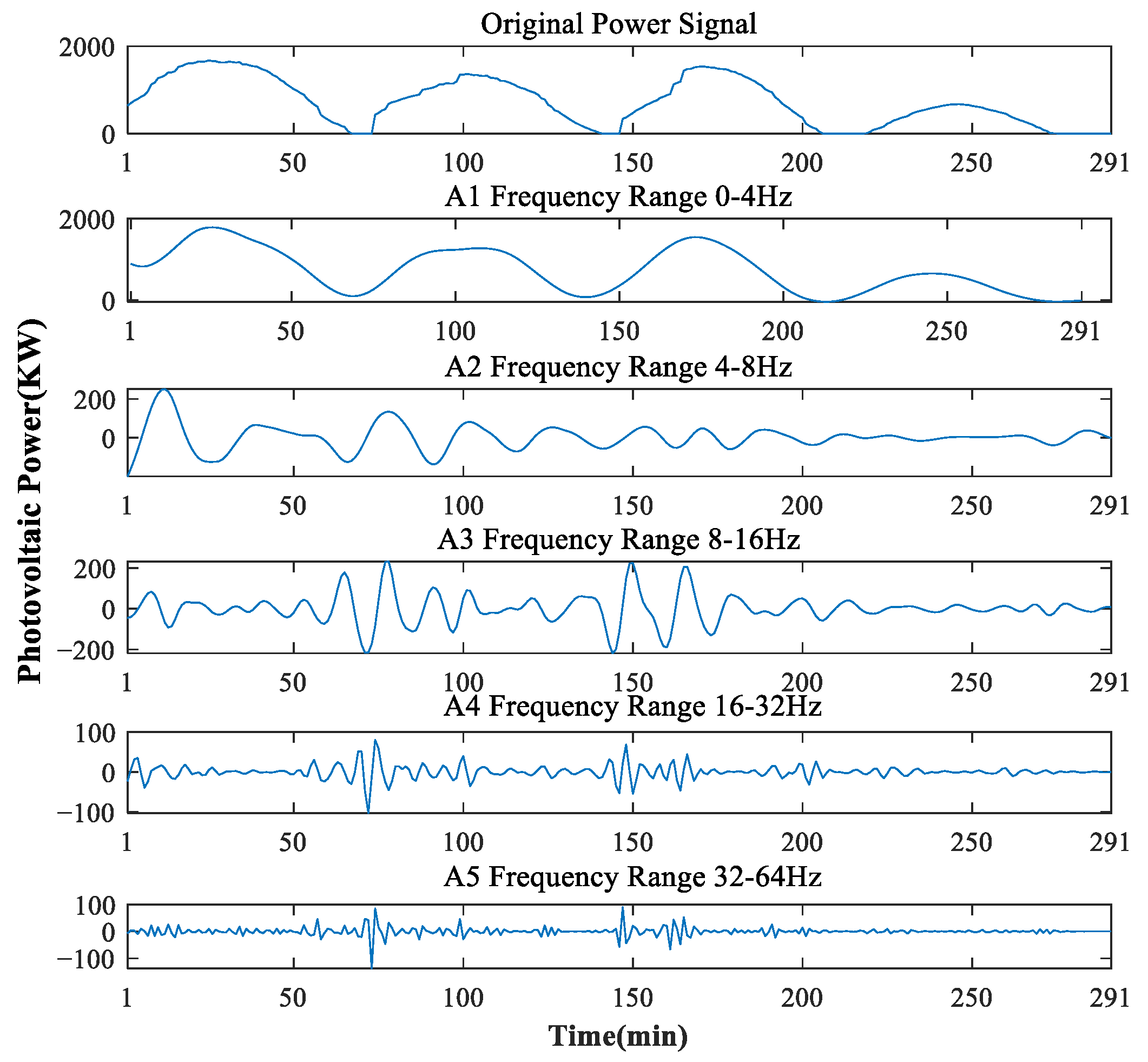
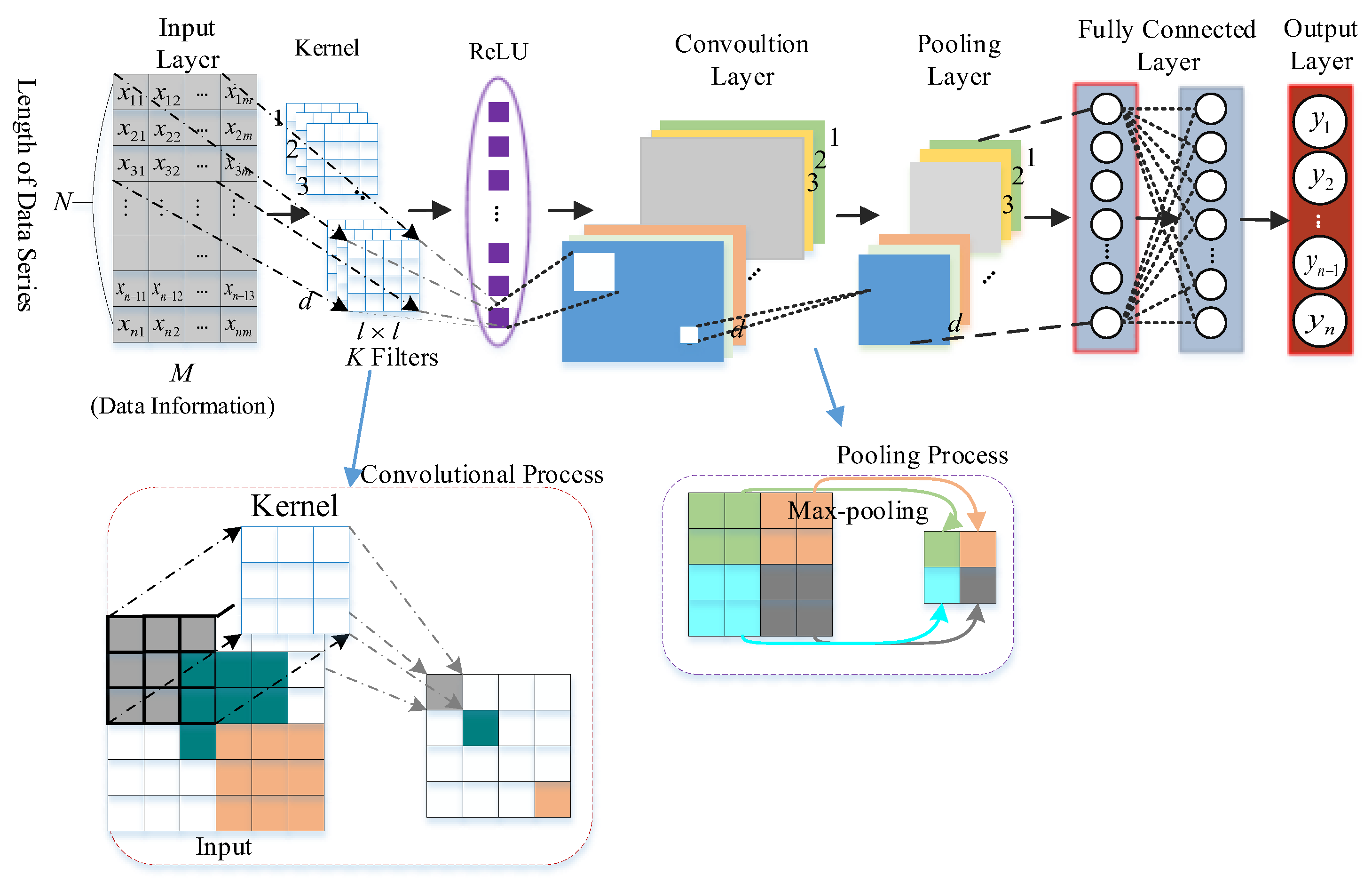
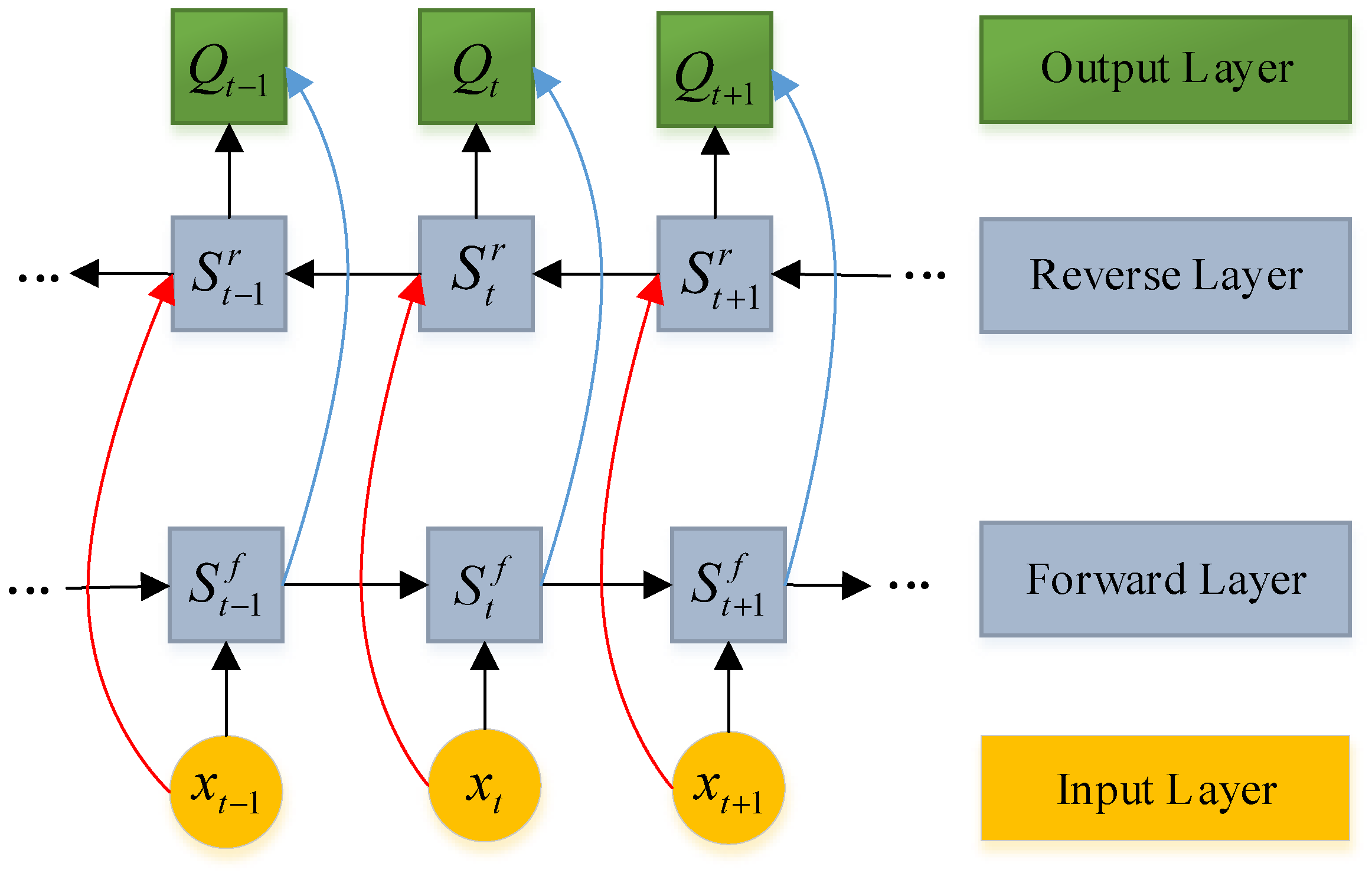
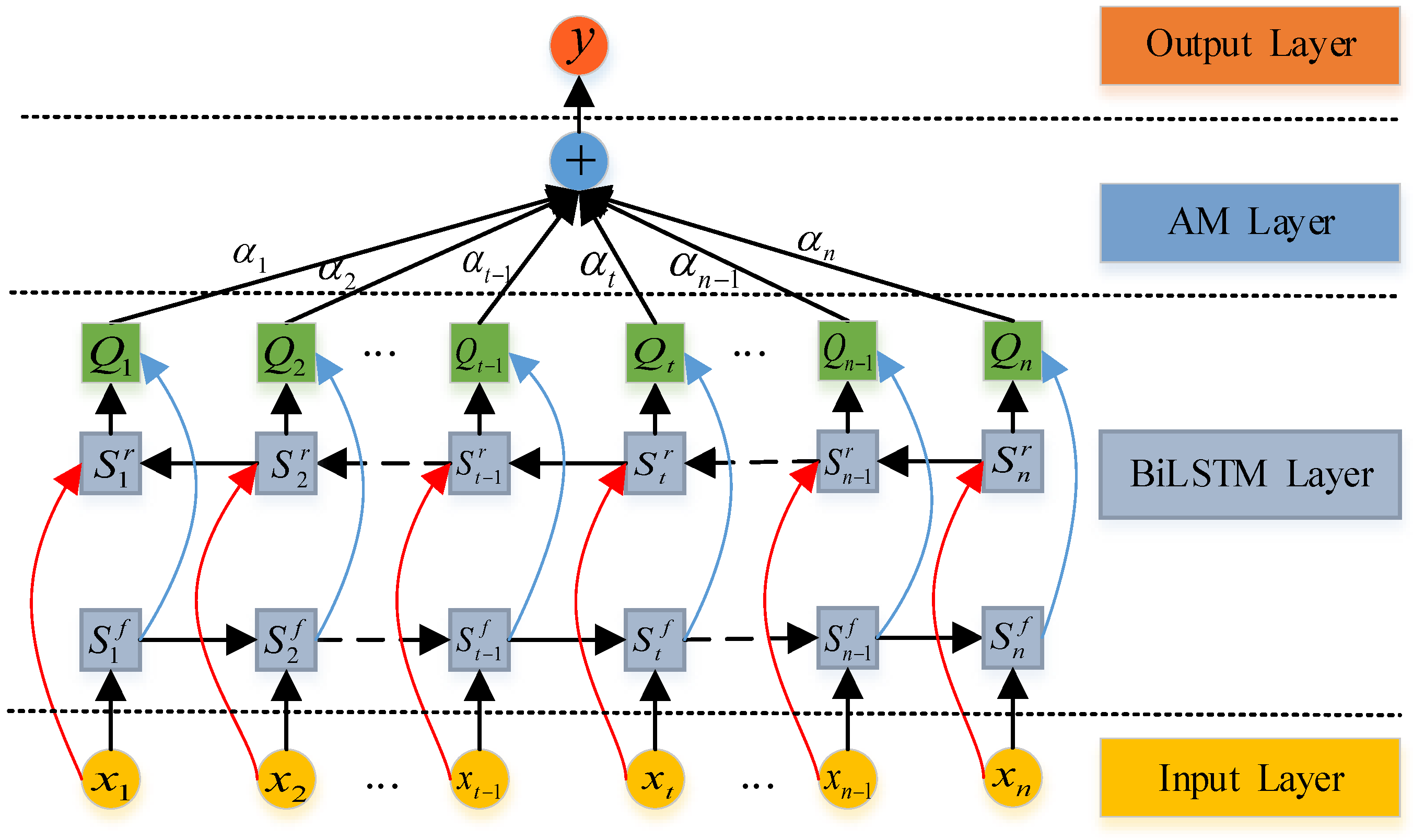
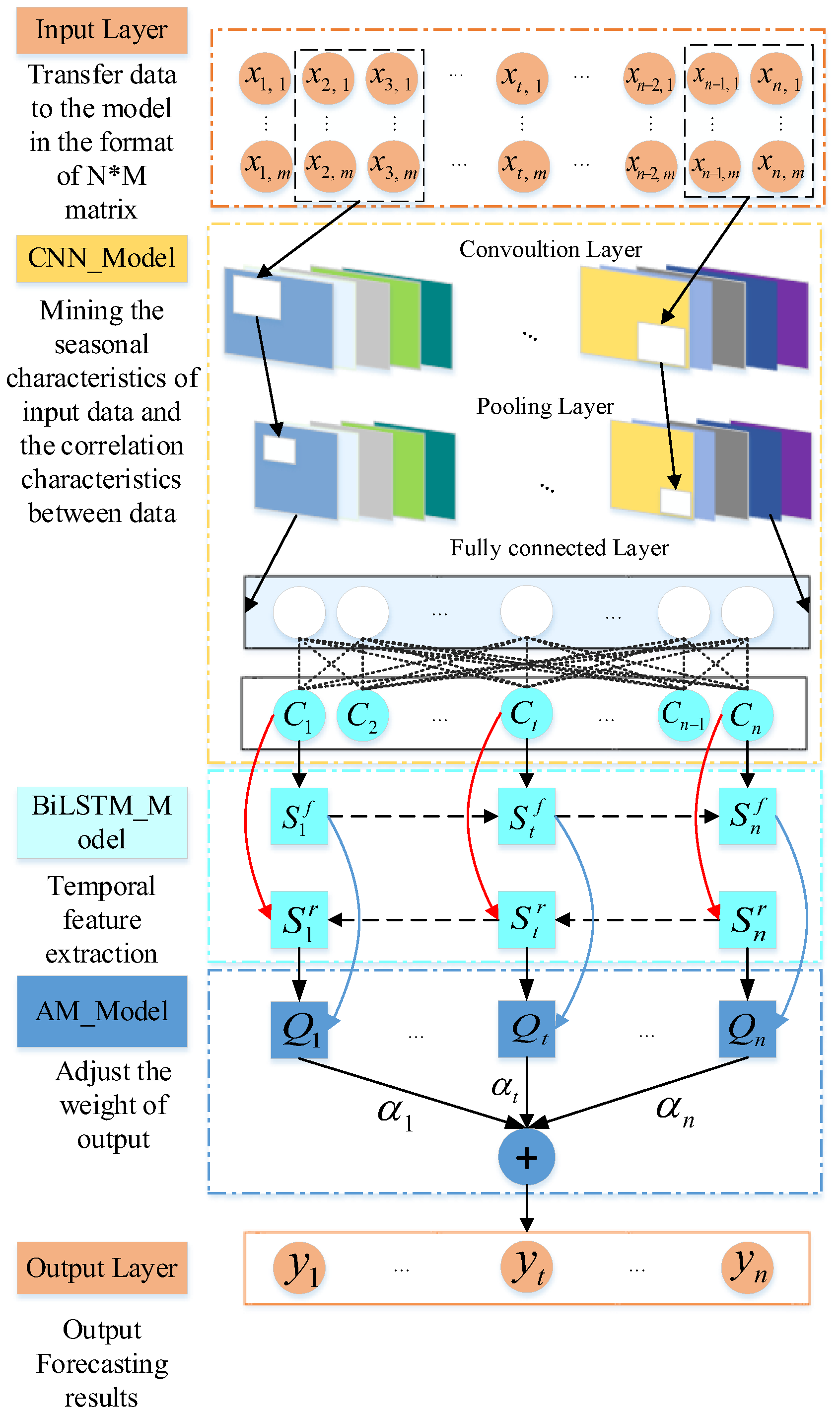
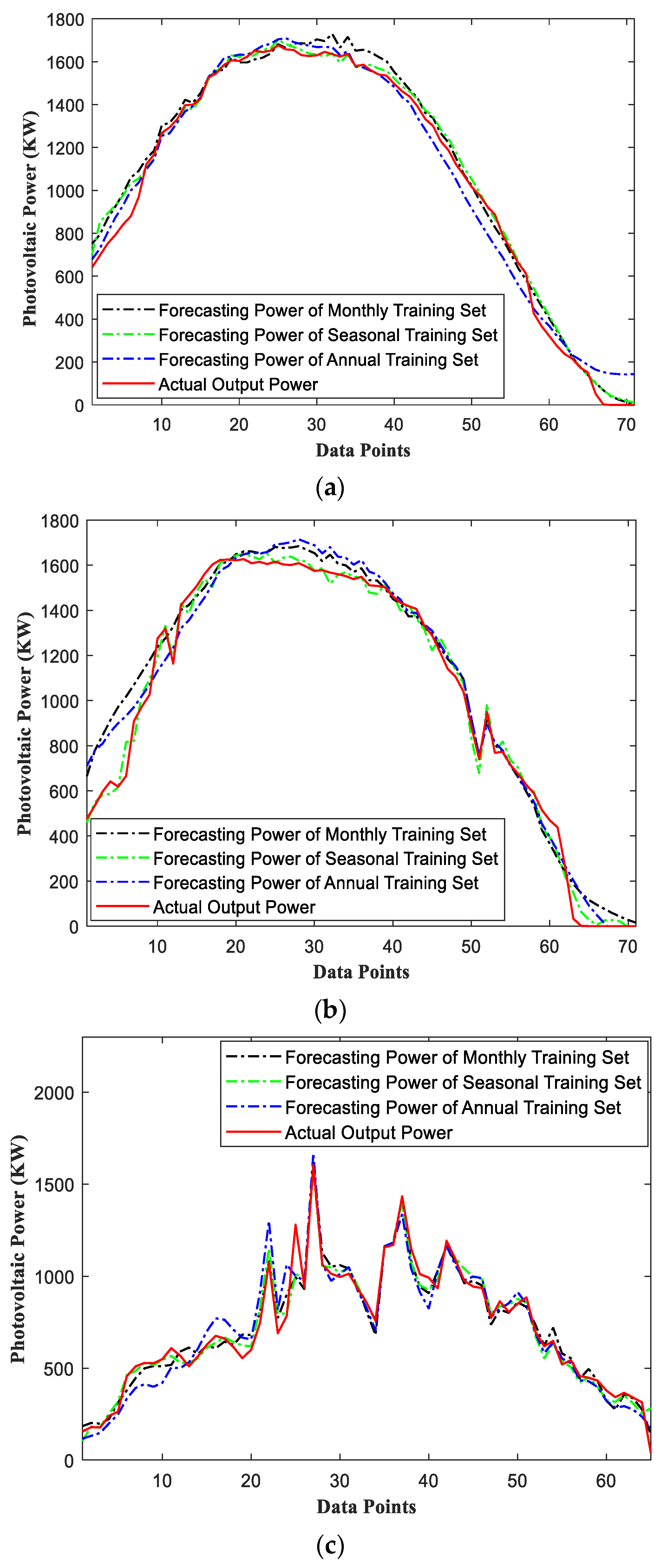
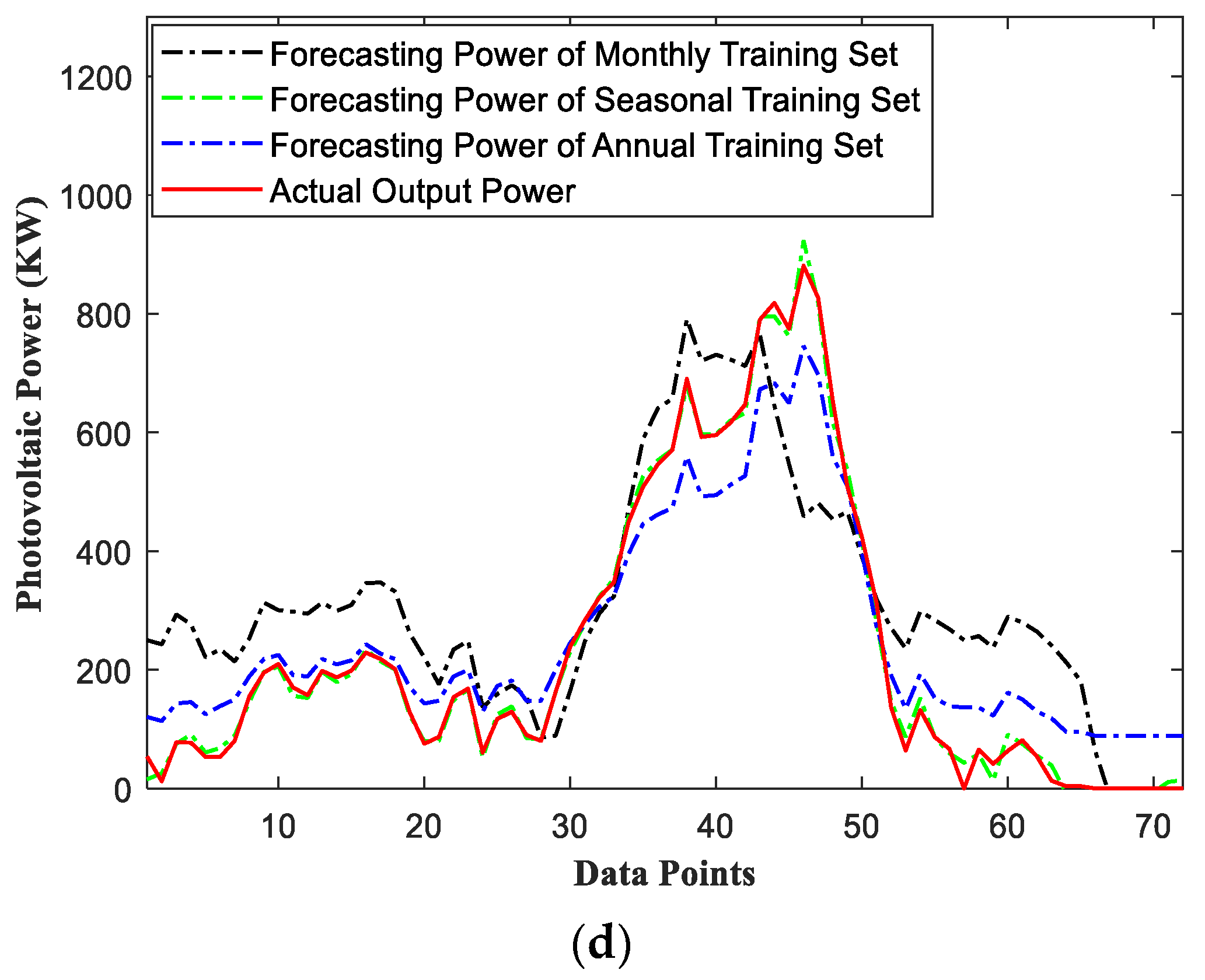
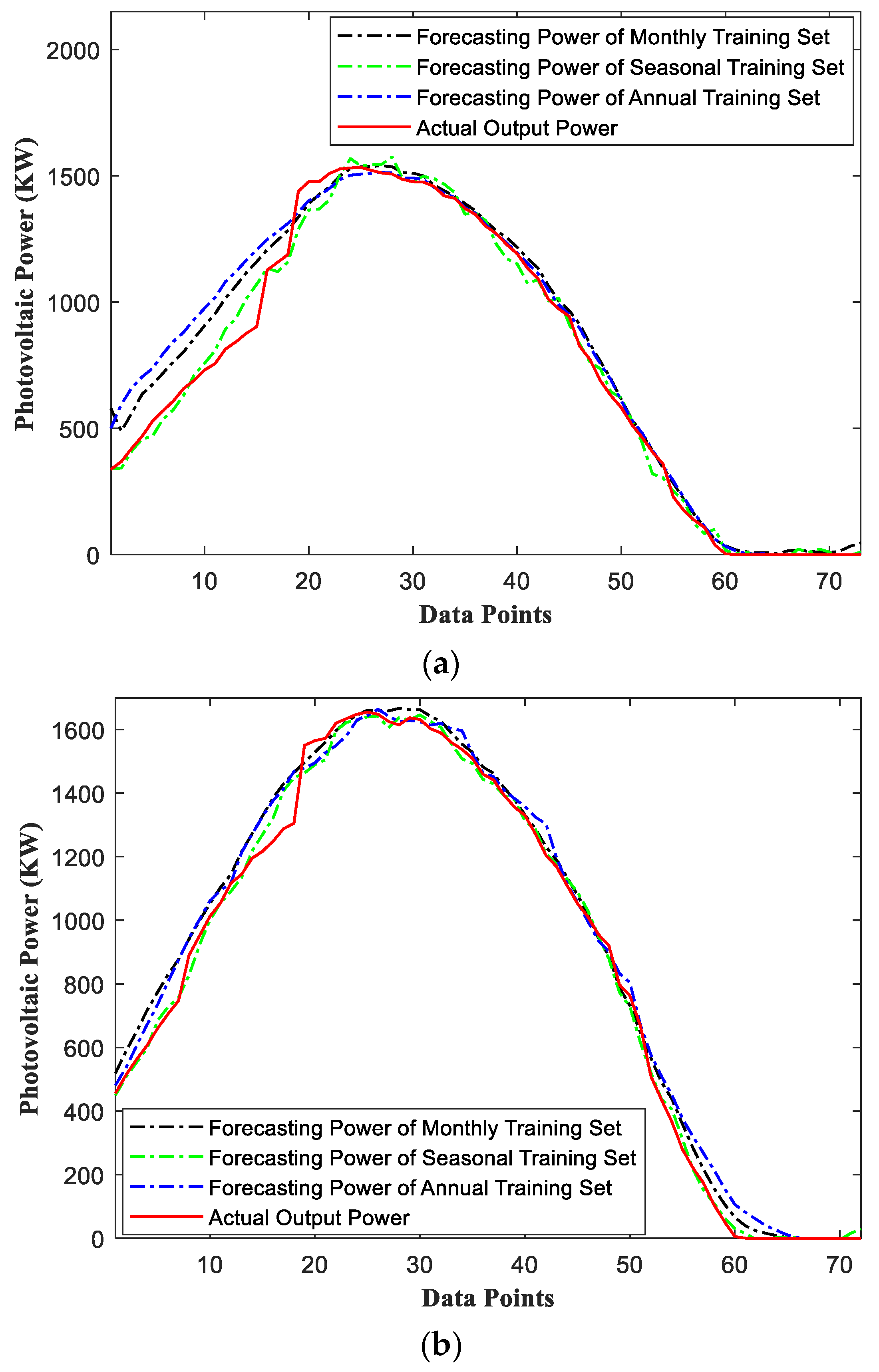
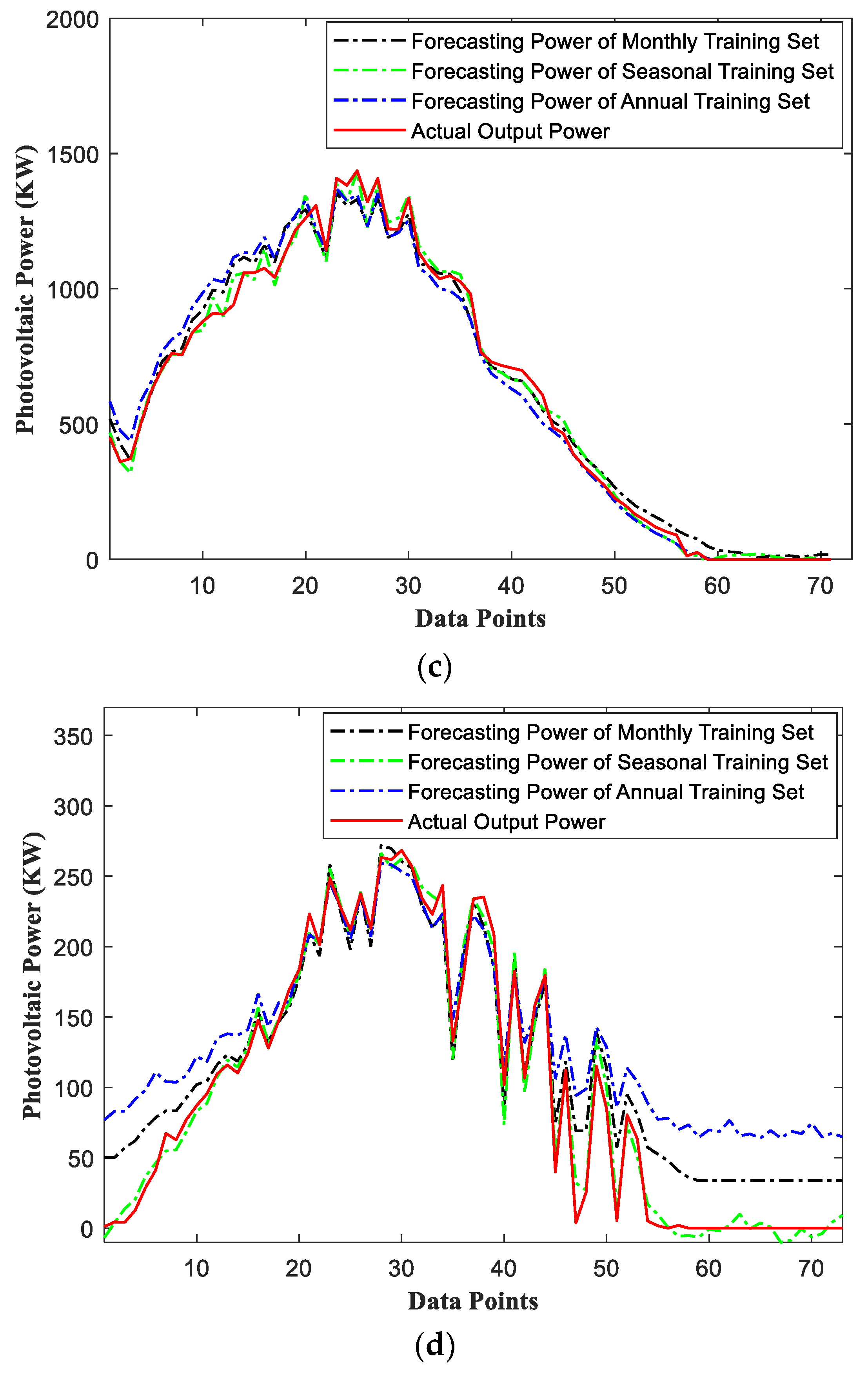
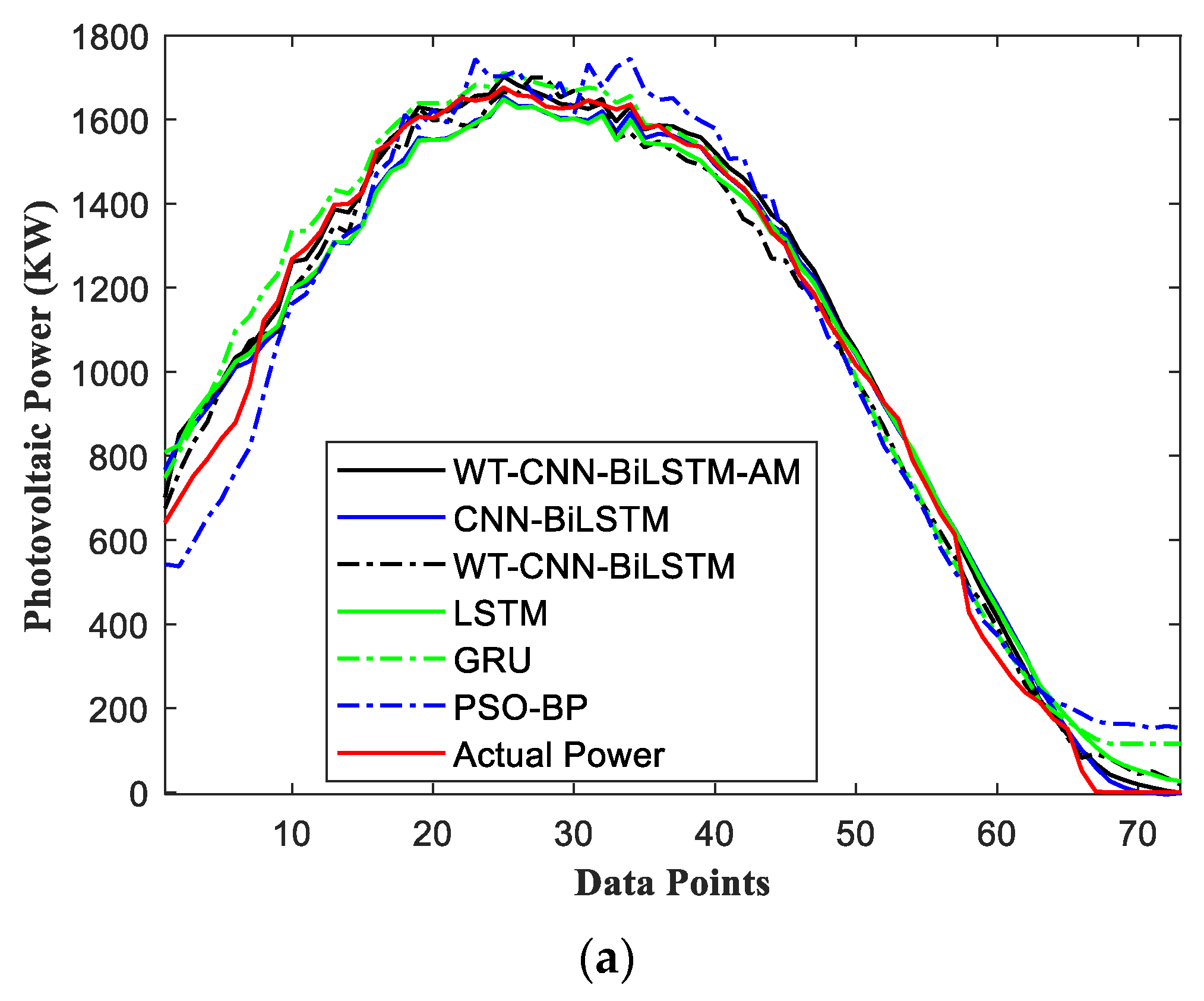
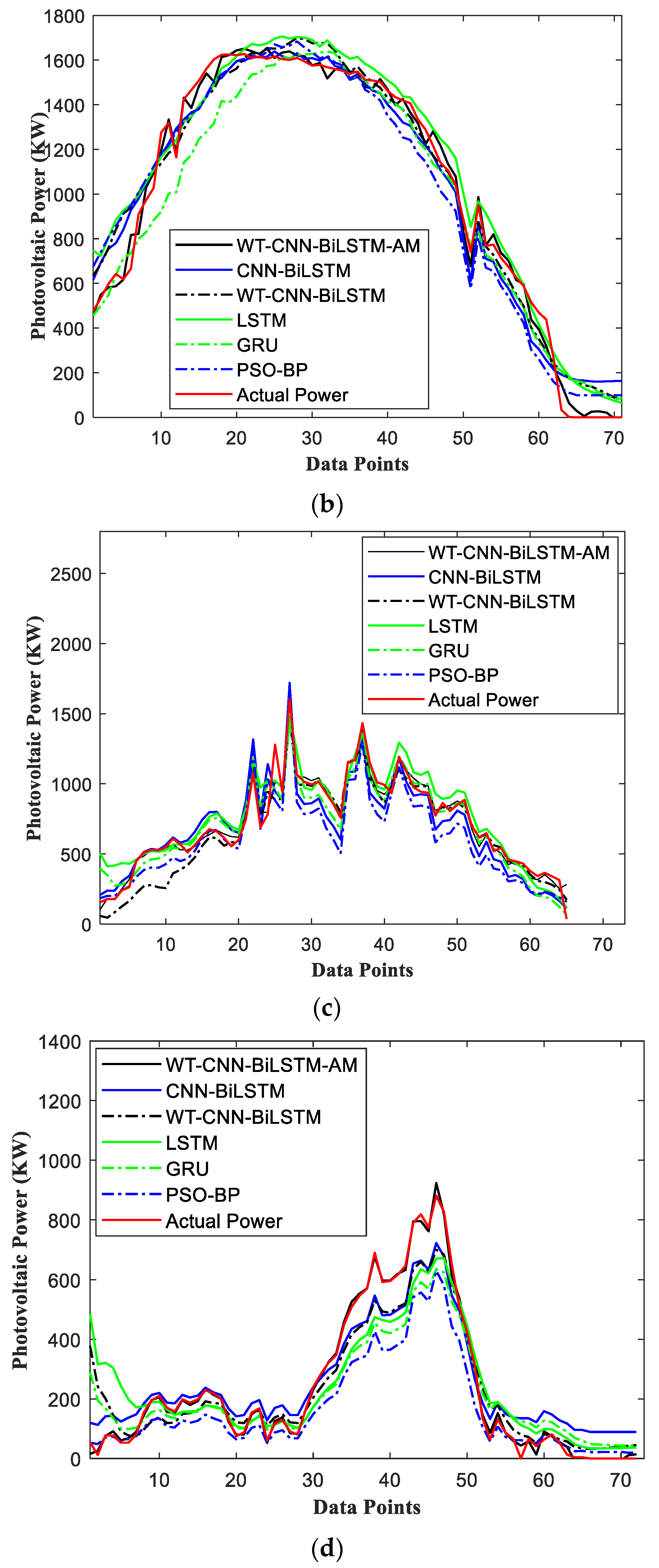
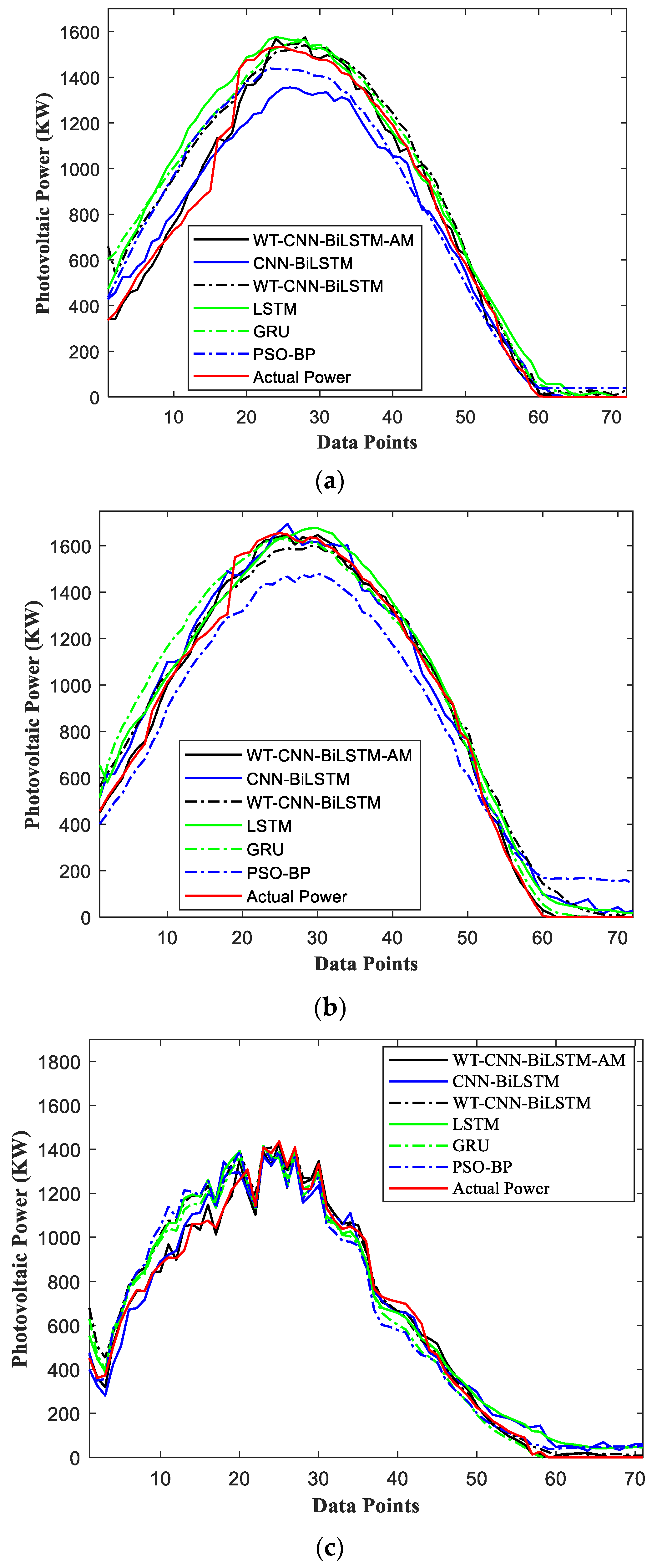
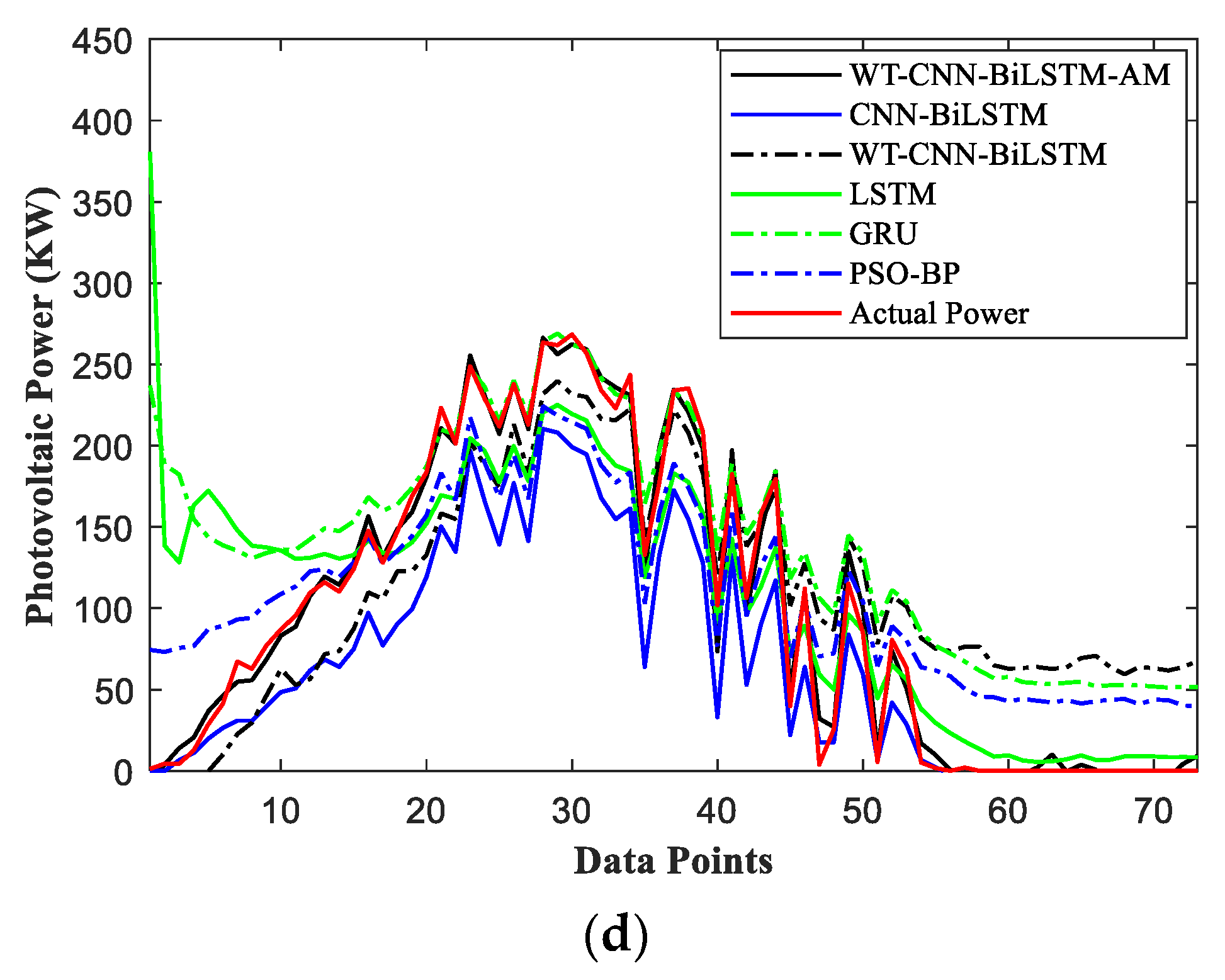
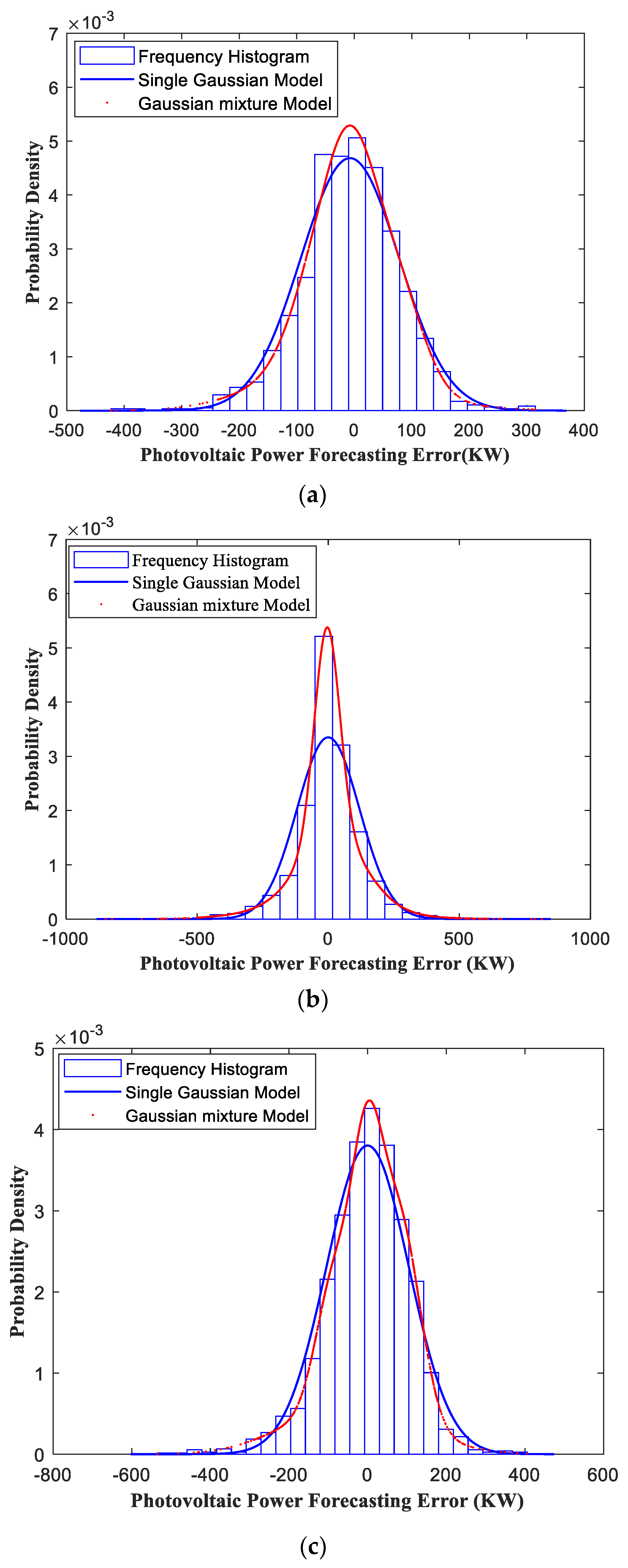
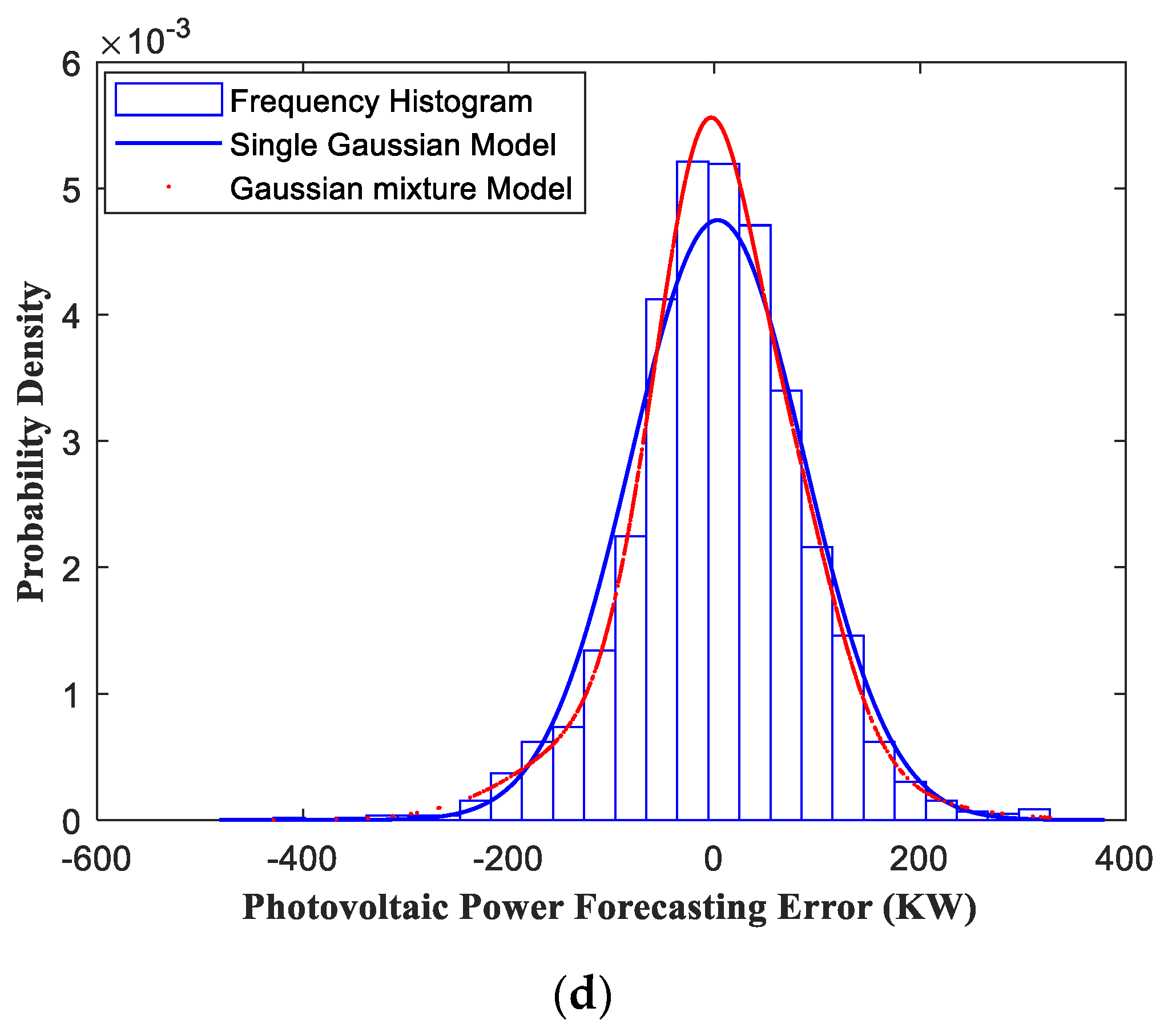
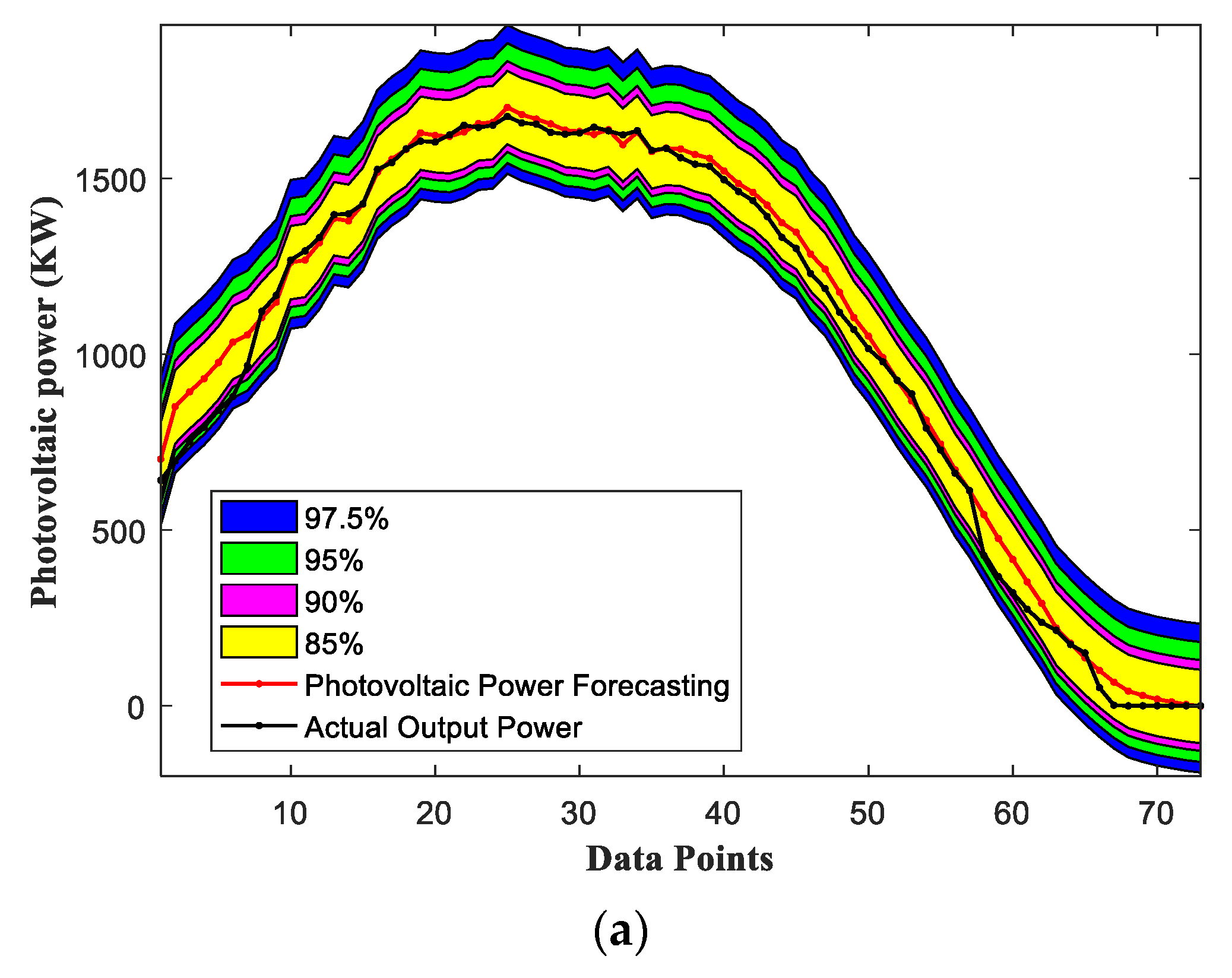
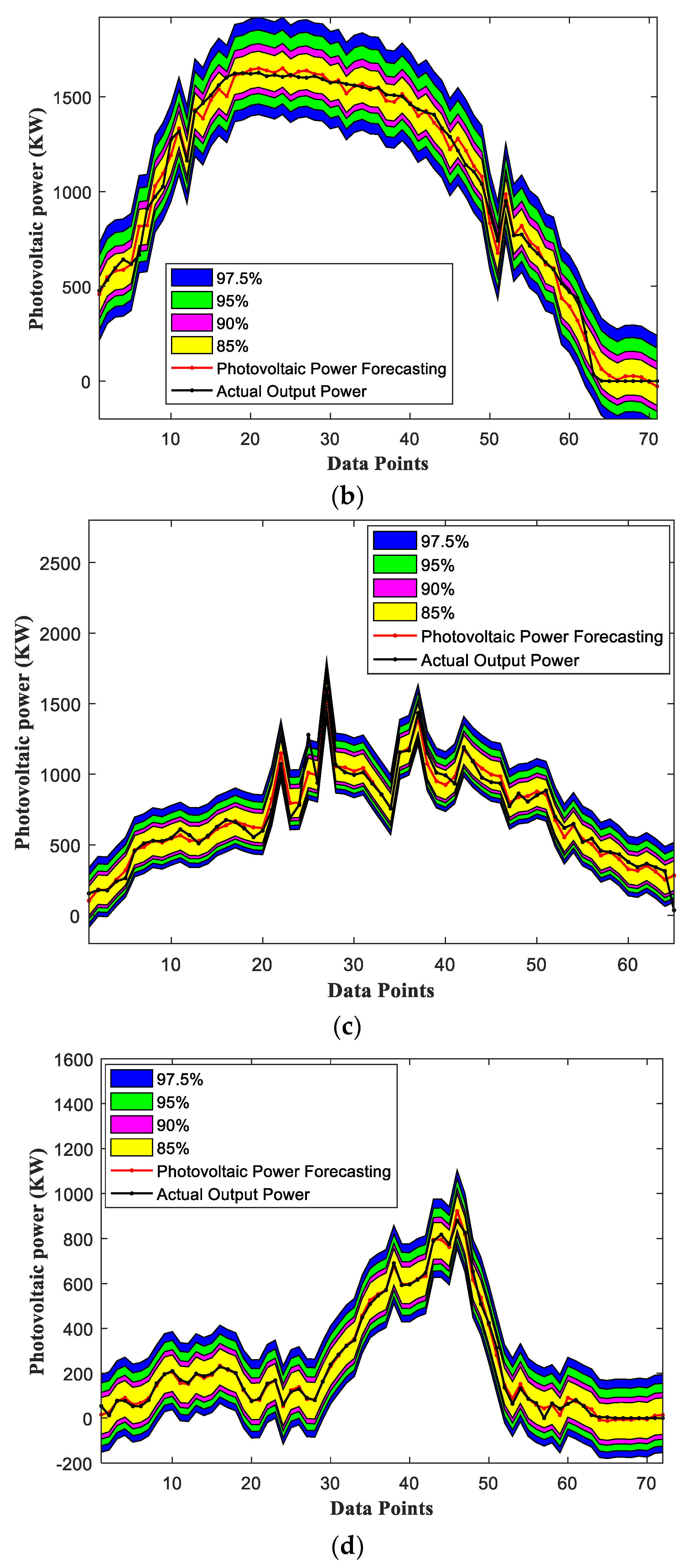
| Season | Error Type | Monthly Training Set | Seasonal Training Set | Annual Training Set |
|---|---|---|---|---|
| Spring | PMAE | 2.61% | 1.94% | 3.21% |
| PRMSE | 3.44% | 2.73% | 4.21% | |
| Summer | PMAE | 2.91% | 1.44% | 3.56% |
| PRMSE | 4.02% | 1.93% | 4.91% | |
| Autumn | PMAE | 1.92% | 1.07% | 2.37% |
| PRMSE | 2.58% | 1.50% | 3.31% | |
| Winter | PMAE | 1.43% | 0.81% | 1.71% |
| PRMSE | 1.81% | 1.08% | 2.32% | |
| Error average | PMAE | 2.22% | 1.32% | 2.71% |
| PRMSE | 2.96% | 1.81% | 3.67% |
| Season | Error Type | WT-CNN- BiLSTM-AM | CNN- BiLSTM | WT-CNN- BiLSTM | LSTM | GRU | PSO-BP |
|---|---|---|---|---|---|---|---|
| Spring | PMAE | 1.94% | 3.56% | 3.11% | 3.70% | 3.55% | 4.54% |
| PRMSE | 2.73% | 4.32% | 4.06% | 4.73% | 4.56% | 5.55% | |
| Summer | PMAE | 1.44% | 4.23% | 3.93% | 4.47% | 4.42% | 5.19% |
| PRMSE | 1.93% | 5.63% | 5.51% | 6.2% | 5.93% | 6.79% | |
| Autumn | PMAE | 1.07% | 2.76% | 2.73% | 2.97% | 2.88% | 3.91% |
| PRMSE | 1.50% | 3.35% | 3.62% | 4.13% | 4.08% | 4.54% | |
| Winter | PMAE | 1.53% | 2.13% | 1.88% | 2.45% | 2.53% | 3.58% |
| PRMSE | 2.24% | 2.94% | 2.95% | 3.24% | 3.21% | 4.01% | |
| Error average | PMAE | 1.32% | 3.17% | 2.91% | 3.40% | 3.34% | 4.30% |
| PRMSE | 1.81% | 4.06% | 3.91% | 4.56% | 4.44% | 5.22% |
| Season | Date | Confidence Level | |||
|---|---|---|---|---|---|
| 97.5% | 95% | 90% | 85% | ||
| Spring | 4.29 | 100% | 100% | 93.15% | 90.41% |
| 4.14 | 100% | 100% | 98.59% | 94.36% | |
| 4.2 | 100% | 96.92% | 96.92% | 95.38% | |
| 4.19 | 100% | 100% | 100% | 100% | |
| Summer | 8.13 | 100% | 100% | 100% | 100% |
| 8.16 | 100% | 100% | 100% | 97.22% | |
| 8.17 | 100% | 100% | 97.26% | 94.52% | |
| 8.5 | 100% | 100% | 100% | 100% | |
| Autumn | 10.12 | 98.61% | 97.22% | 90.27% | 84.72% |
| 10.9 | 100% | 100% | 98.61% | 97.22% | |
| 10.3 | 100% | 100% | 100% | 95.77% | |
| 10.22 | 100% | 100% | 100% | 100% | |
| Winter | 12.17 | 100% | 100% | 100% | 100% |
| 12.15 | 100% | 97.22% | 90.27% | 86.11% | |
| 12.8 | 100% | 100% | 100% | 94.20% | |
| 12.21 | 100% | 100% | 100% | 100% | |
Disclaimer/Publisher’s Note: The statements, opinions and data contained in all publications are solely those of the individual author(s) and contributor(s) and not of MDPI and/or the editor(s). MDPI and/or the editor(s) disclaim responsibility for any injury to people or property resulting from any ideas, methods, instructions or products referred to in the content. |
© 2023 by the authors. Licensee MDPI, Basel, Switzerland. This article is an open access article distributed under the terms and conditions of the Creative Commons Attribution (CC BY) license (https://creativecommons.org/licenses/by/4.0/).
Share and Cite
Gu, B.; Li, X.; Xu, F.; Yang, X.; Wang, F.; Wang, P. Forecasting and Uncertainty Analysis of Day-Ahead Photovoltaic Power Based on WT-CNN-BiLSTM-AM-GMM. Sustainability 2023, 15, 6538. https://doi.org/10.3390/su15086538
Gu B, Li X, Xu F, Yang X, Wang F, Wang P. Forecasting and Uncertainty Analysis of Day-Ahead Photovoltaic Power Based on WT-CNN-BiLSTM-AM-GMM. Sustainability. 2023; 15(8):6538. https://doi.org/10.3390/su15086538
Chicago/Turabian StyleGu, Bo, Xi Li, Fengliang Xu, Xiaopeng Yang, Fayi Wang, and Pengzhan Wang. 2023. "Forecasting and Uncertainty Analysis of Day-Ahead Photovoltaic Power Based on WT-CNN-BiLSTM-AM-GMM" Sustainability 15, no. 8: 6538. https://doi.org/10.3390/su15086538
APA StyleGu, B., Li, X., Xu, F., Yang, X., Wang, F., & Wang, P. (2023). Forecasting and Uncertainty Analysis of Day-Ahead Photovoltaic Power Based on WT-CNN-BiLSTM-AM-GMM. Sustainability, 15(8), 6538. https://doi.org/10.3390/su15086538





